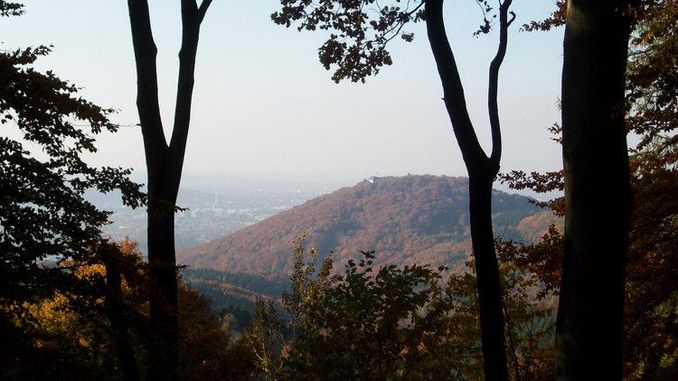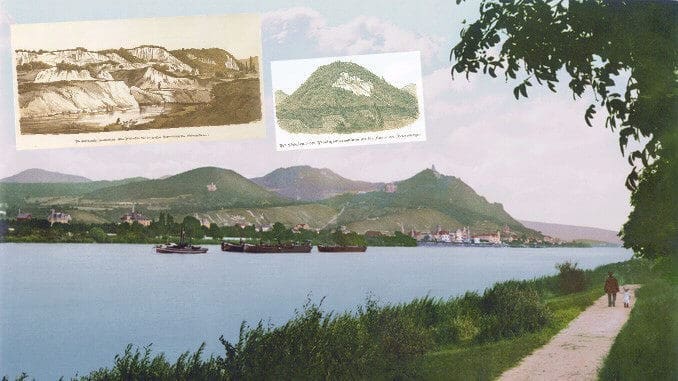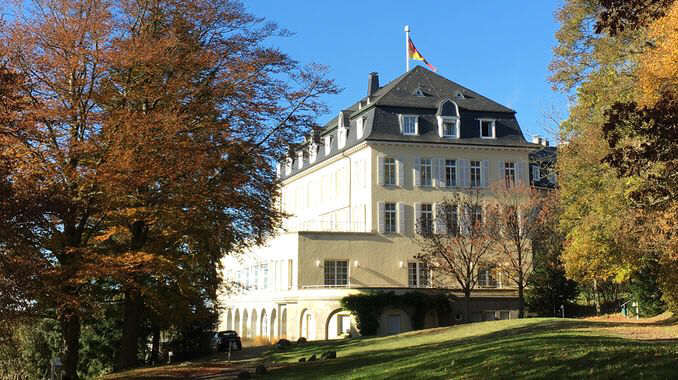
Mount Petersberg in the Siebengebirge is a worthwhile destination not only for state guests. You may have heard the correspondent from Germany speaking about the “The Petersberg close to Bonn” because the Grand Hotel on the Petersberg is still the guesthouse of the Federal Government and a venue for international conferences.
In fact, the Petersberg is located in Königswinter. But also you and I can visit the hotel and the restaurant and enjoy the wonderful view.
His Excellency Mount Petersberg indeed is interesting, not only because of his diplomatic tasks. Its history takes us from the Stone Age to the present. Mount Petersberg and its surroundings were already settled around 3,500 BC, perhaps there was a prehistoric settlement on the “Mondscheinwiese” (Moonlight meadow) between the mountains Petersberg and Nonnenstromberg.
Early settlement and ring wall
Around 100 B.C. a mountain fortress stood on the Petersberg, of which remains of the ring wall of Celtic type have remained. But we do not know for sure who lived here. The Siebengebirge was located in the border area between the Celtic civilization in the south and the Germanic world in the north, but neither Celts nor Germanic tribes knew written language.
Cistercians in the Siebengebirge
Let us make a big step into the High Middle Ages during the time of Emperor Frederick I Barbarossa. Back then, the Archbishops of Cologne were mighty men in the Holy Roman Empire and in our region. The acting archbishop was Philipp von Heinsberg, a very power-conscious man who sought to fortify his position.
On the Stromberg, today’s Petersberg, there was a small church which Augustinian monks had built some twenty years ago. Now they had left, and archbishop Philipp had secured all rights on the mountain to himself.
In March 1189, he called Cistercians from Himmerod to the Siebengebirge. On March 22nd twelve monks under their abbot Hermann came over the Moselle and Rhine to the Stromberg. They moved into the abandoned buildings, extended the church and dedicated it to St. Peter, since then, the mountain was called Petersberg. The power-conscious archbishop was satisfied. Now that Cistercian monks had settled on Petersberg, no other nobleman could build his castle there – especially not the immediate neighbors, the Counts of Sayn and the Counts of Berg.
Three years later, the monks Mount Petersberg and settled in a valley nearby, the valley of Heisterbach.
In 1312, the church on the Petersberg became a place of pilgrimage, as well as the Monastery of Heisterbach. For centuries, people came here, and you see many stone crosses on the ways up to the top of Petersberg. Yet, the medieval church has not remained. In 1765, the abbot of Heisterbach had a new chapel built in baroque style. Formula 1 champion Michael Schumacher got married here.
Quarries
As I said upon welcoming you to my site, the quarries almost destroyed our region. In the 19th and early 20th centuries, when basalt was needed for the construction of roads and, somewhat later, railway lines. Large quarries were opened at the mountains Weilberg, Petersberg and Ölberg. The Rhine front in neighboring village Oberkassel was soon devastated. Finally, the damage to nature alarmed many people. At that time two associations were founded to protect the Siebengebirge, which later merged to form the Verein zur Verschönerung des Siebengebirges (VVS).

A bad quarry on the Rhine front
In the 1880s, when the rack railway was being built at Mount Drachenfels, a gigantic quarry was opened on the Rhine side of Mount Petersberg. Soon many people felt it to be a “gaping wound” and suffered with the mountain.
Justizrat Humbroich from Bonn took up the fight. In 1884, a direct submission to Crown Prince Friedrich was denied. Even worse, shortly afterwards the administration of the Rhine Province acquired the quarry and exploited it itself, even more intensively than before. Despite all sympathy, the VVS, and Humbroich was himself on the board, did not want to put itself in the front line against the Prussian authorities.
So, they decided to found the “Verein zur Rettung des Siebengebirges” (Association for the rescue of the Siebengebirge) chaired by with Humbroich. The VVS stood in solidarity. Humbroich could win over many people for his cause, but still his suggestions to the Landtag in Düsseldorf (the State Diet of the Prussian Rhine province) fell on deaf ears.
The tide turned in his favor when the Prussian State Railway reduced the freight rates for stones, and there were cheaper alternatives to stones from the Siebengebirge. The pressure of public opinion increased, especially as Mount Petersberg with its hotel and rack railway was attracting many tourists. Humbroich now turned to the Landtag in Berlin (the representative assembly of the Kingdom of Prussia) in Berlin, which was more open-minded than the Rhine Province’s provincial Landtag in Düsseldorf. Finally, the provincial authorities gave in, and in 1889 they sold their quarry to the owner of the hotel on the Petersberg, under condition that all quarrying is stopped.
After the closing the quarry on the Rhine side, Humbroich’s association merged with the VVS.
Hotel and quarry Nelles
Now the VVS was determined to work much harder than before for the preservation and protection of the Siebengebirge. There was a lot to do because in many places gigantic quarries went on. Right at Petersberg, on the opposite side, two quarries were operated. One belonged to the brothers Paul and Joseph Nelles from Cologne, who had a hotel built as well, next to the quarry. Since spring 1891, the hotel was receiving guests, and Mount Petersberg soon become a very fine address. Yet, the second quarry run by their competitors was a thorn in the Nelles’ side. The workers blasted the stones out of the mountain, and this was not only disturbing the guests and sightseers, but downright dangerous. After long confrontations, the quarry owner sold it to the VVS. In March 1903, the quarry was closed down.
The Nelles, however, had no problem with their quarry. Negotiations and disputes went on for years unsuccessfully. Then Paul Nelles got into financial difficulties, all his property on Mount Petersberg was sold in forced-upon auctions. On 30 April 1908, the VVS auctioned off the quarry and closed it down. Finally, the reforestation could begin.
Hotel Mühlens
In 1912 construction works were going on Mount Petersberg. Mr. Ferdinand Mühlens of “4711” in Cologne had a new hotel built. His family owned the Wintermühlenhof estate beneath Mount Petersberg. After handing over the company to his son, Königswinter became his center of life. He was very committed, had roads and paths built and bought the rack railways to the mountains Drachenfels and Petersberg. The hotel was larger and even more luxurious.

State Guests on Mount Petersberg
After the Second World War, world politics shifted Mount Petersberg in the Siebengebirge into the public eye. The victorious powers reserved the right to themselves to control German policy and formed the Allied High Commission which from 1949 to 1952 took residence in the hotel on top of Mount Petersberg. Here the important “Petersberg Protocol” was negotiated that opened the way into economic reconstruction and independence. By the way: while the Allied High Commissioners had their residence on Mount Petersberg, they often used the cog train, which was restored for that purpose.
Between 1954 and 1973, the hotel hosted the state guests of the Federal Government, among them the Shah of Persia, Reza Pahlavi with his wife back then, Soraya, in 1955 and then again in 1967 with his third wife Farah Diba, in 1965 Queen Elizabeth II of Great Britain, and in 1973 the Secretary General of the Communist Party of the Soviet Union, Leonid Breshnev. The hosts gave him a brand-new Mercedes as a present, and he insisted on taking it for a test-drive down the serpentine road right away … which unfortunately ended in the roadside ditch.
Today the old hotel does not exist anymore. In its place, a new guest house for the Federal Government was built. It modeled on the old hotel, saving some old stones. This hotel, too, has had its share of prominent guests, among them Hillary and Bill Clinton. We all can rund the Bill-Clinton-jogging-trail around the summit of Petersberg.
 German names
German names
Petersberg; masculine in German, Mount St. Peter. As we have seen above, the Cistercian monks gave this new name to the former Stromberg when they came into the Siebengebirge.
Read more (German)
https://www1.wdr.de/nachrichten/bonn-petersberg-wieder-eroeffnet-100.html

Be the first to comment